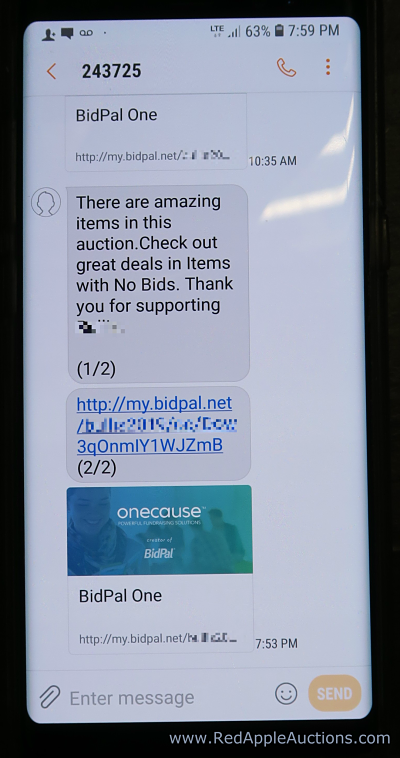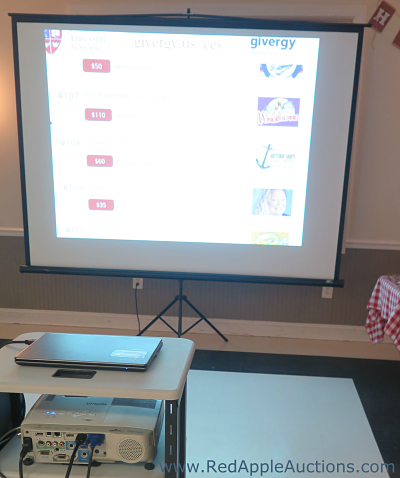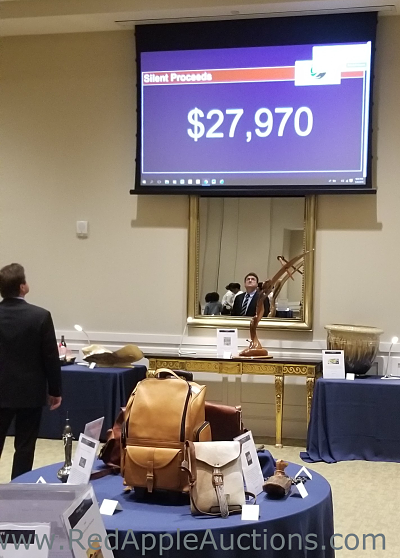
This school used the OneCause / Bidpal system. This was the home screen of the mobile bidding system.
I worked a fundraising gala this weekend in Martha’s Vineyard, MA and the nonprofit used mobile bidding in its silent auction.
Because it’s on my mind, today I’m addressing three conversations that often arise about mobile bidding.
=============================
1. “Mobile bidding” isn’t synonymous to “nonprofit auction software.”
I know, the jargon is confusing.
Better to say that mobile bidding is a feature of some nonprofit auction software platforms.
Referring to them as the same thing is a bit like suggesting frosting is the same as a cake. In actuality, you need cake to have frosting.
(Bad analogy, but you get the idea.)
For instance, one of my client’s uses GreaterGiving software. For two years, my client used the feature of mobile bidding. They are discussing the idea of not using it next year. It’s optional.
There are over 35 nonprofit auction software platforms.
Some software vendors don’t even offer mobile bidding as a feature.
Another way of saying it: Mobile bidding requires software, but (most) software doesn’t require mobile bidding.
=============================

This school client used OneCause’s mobile bidding feature in its silent auction.
2. Is mobile bidding the best way to run a silent auction?
It depends.
Whether mobile bidding is a great idea for your silent auction depends on the type of fundraising gala you hold, your risk level, and other factors.
Sometimes I encourage it.
Multi-day conferences, multi-floor venues, and events with large guest counts or item counts come to mind.
Also, fundraising auctions suffering from a lack of support / volunteers in the registration and checkout process are helped by mobile bidding.
But mobile bidding isn’t required for a successful gala.
One of my nonprofit clients has two younger co-chairs. They prefer not to use mobile bidding.
“Our husbands are on their phones enough,” they said, “we don’t want to go to a social function and give them a reason to walk around with phones in hand.”
And sometimes people don’t want to risk technology failure at the auction. They opt for unsexy paper bid sheets.
Make the decision after taking into consideration your fundraising event’s strengths and weaknesses.
=============================

This client projected their silent auction mobile bidding activity (run by Givergy) onto a screen in the room.
3. Will mobile bidding raise more money in the silent auction?
If your sales rep insists you’ll raise more money when you use mobile bidding, ask for that in writing with a money-back guarantee.
Actually, I’d recommend paying the extra fee to have their staff run the system for you at the gala, so they can’t say you didn’t know what you were doing when those big numbers don’t materialize.
In March 2019, I received an email from Dawn, the Executive Director for a San Antonio, TX nonprofit.
She wrote:
“Maybe everyone is already on the software bandwagon – but an article about the costs vs benefits of going the software way would be helpful! I see everyone looking at their phones everywhere I go! Do we really want an event where everyone feels they must stare at their phones – and not interact with each other — in order to win the silent auction item of their dreams!??”

This client used pre-existing screens at the catering center to show their silent auction mobile bidding bids into the room.
She surprised me with this:
” … I still am not 100% sure about moving from old-fashioned bid sheets (where guests mingle and look for items) vs putting everything on their phone (I hate looking at the tops of people’s heads!).
But the companies all insist you’ll get 30% higher returns if you allow mobile bidding!! Ugh!”
When mobile bidding was introduced a decade ago, I heard that 30% number a lot. One vendor promoted a 50% improvement.
In recent years, I’d thought the mobile bidding sales reps had backed off those aggressive claims.
Here’s what I think: Nonprofit auction software has these benefits.
- It saves you time. – Critical
- It reduces effort over time. — Especially helpful as you pass the auction baton to new people
- It can increase your happiness (i.e. feel more organized / in control). Don’t discount this. Auctions are stressful; happiness matters.
As we’ve already covered, mobile bidding is a feature of some software programs.
In my mind, mobile bidding has these benefits:
- It saves you time. – Important!
- It reduces / avoids effort onsite. – Critical!
- It’s fun.
- You can gain praise (“Aren’t you cool, using high tech tools!” or “Thanks for letting me bid from my house, since I couldn’t attend the event this year!”)
But I’d not say that one of the reliable benefits is that mobile bidding raises you more money.
In fact, based on my clients data, well-run silent auctions that switch from paper bid sheets to mobile bidding don’t see a financial increase. Results show a flat line or a slight decrease.
“Well-run” is the key descriptor. Many nonprofits simply aren’t running tight silent auctions.
- They have too many items for the crowd size.
- The items offered are weighted towards unpopular items, like services.
- Bid sheets are sloppy, using odd increments, layouts, and design. (This is proliferated by the poorly structured — but free! — bid sheets promoted online.)
- They close the silent auction incorrectly.
- The onsite set up is bad.
- And on and on ….

Screens in the catering hall displayed the results of the silent auction.
Sometimes the first significant change a nonprofit makes to improve its silent auction is to buy software and use the mobile bidding feature.
With this virgin investment, other things start to change, too.
Specifically, the nonprofit team begins to get educated.
- They watch trainings offered by the vendor
- They listen to their auction consultant
- They make adjustments
- And VOILA! — they raise more money
Was the overall financial gain due to the mobile bidding feature?
Or was the financial gain due to other elements, such as — for the first time ever — using better bidding increments, better layouts, changing the closings, and so forth?
Based on my experience with clients who had well-run silent auctions and then made a switch, I know it’s the overall tightening of the silent auction that helped the bottom line finances.
The mobile bidding feature was one of many changes — some subtle, some not. Mobile biddings specific benefits were what I mention above (e.g. save time, avoid effort), but not “raise more money.”
=============================
What’s your take?
Post any comments below.
Approach mobile bidding with caution! We have a very well-run Silent Auction and have been using Silent Auction checkout software for years. We also follow the rules for a good silent auction; appropriate number of packages for the number of guests, drop items earning less than 40% of value each year and replace with new ones, bump up the ‘Buy It Now’ price on items we know will be popular based on past data, good variety of packages, well displayed, etc. Our auction is very successful. I say this just so you know we are not neophytes.
We decided to try mobile bidding a few years ago, based on the success stories/sales pitch we heard from many sources and our well-regarded long-time auction software provider. Some lessons we learned:
1) Unless you already enter a photo and short description for every item because you have your auction online, it is a LOT of extra work to do just that. Our auction is only available at the event, so entering a photo/logo and super short yet thorough description was a ton of extra work we did not anticipate.
2) Does your venue have enough wi-fi capability to handle the majority of your guests being on the phone at once? If your event is not in a city, this could be an issue or you may incur an extra costs to boost the wi-fi, and that’s not always successful.
3) Do you have a Plan B if the mobile bidding site goes down? Our very large well-known provider’s system crashed an hour before our event started. This also happened to be a time when many of our guests were clicking on the link to register themselves. Fortunately, they got it working again about 15 minutes before our event started. We had enough blank bid sheets to place at each space if we had to, but they had no starting bid, Buy It Now price, bidding increments, or description on them, because, well, the idea was to not have to print bid sheets.
4) It is imperative to try and get your guests to register well before the event – our check-in lines were the longest they had been in years because most people ignored the emails sent earlier to log in. People were restless, we had to serve more wine while folks were waiting, and then the crowd was a little bit overserved by the time the dinner and Live Auction started – past the point of it being a good thing.
5) Know your crowd . Our crowd, while fairly young and very tech-savvy – hated mobile bidding. We are located in a small resort ski town, and there is a lot of ‘friendly’ competition. People want to see what their buddy bid on, and then go out-bid them.
We ended up doing about the same or maybe a little bit worse with mobile bidding, so it certainly wasn’t worth the extra time, effort, and cost. This was our particular situation, of course others have been really successful. As I said at the beginning, I would approach with caution:)
I’ve worked events whereby the system went down — 4 or 5 times last year, actually. It’s so stressful for the organizers and confusing for guests, who aren’t sure if it’s their phone/connection, their inability to understand the system, or some other issue.
Mobile bidding — like so many other technology gadgets — reminds me of that old Longfellow poem:
“…when she was good,
She was very good indeed,
But when she was bad she was horrid.”
Thanks for sharing your experiences, Jennifer.
As someone who sells auction software with this option: right on, Sherry.
The other consideration I’d toss in is: how enthusiastic will *your organization’s* guests be about this option? Just because it works well for one set of supporters doesn’t mean that they all feel the same way.
So I really recommend a quick survey of 10-20 guests from last year – they’ve probably seen it in use at other auctions; what did they think? Was it fun? Did it encourage *them* to bid more? (Beware the “I personally don’t like it, but I think everyone else did!” answer.)
Anyway, excellent advice, as always.
Good ideas. Thanks, Roger.
Hi Sherry,
We moved to online bidding (people may use cell phones or laptops in the room) in 2014.
We didn’t see a huge increase in profits, but have experienced much happier volunteers, employees and patrons. Our event is a multi-day event, which made it difficult for bidders to come back and check on bids. With online bidding, they receive an email immediately upon getting outbid and can then decide to bid again. We’ve also had multiple patrons who were out of town the week of the event and get excited when they can look at all of our items and bid online.
There have been a few patrons who declared they don’t like the online bidding and were never going to bid again. Upon researching their accounts, they never purchased anything when there was paper bidding!
Thank you for your great tips and ideas!
Teresa, given your multi-day event, I think your auction was a perfect candidate for mobile bidding. And of course, thanks for sharing your other insights.